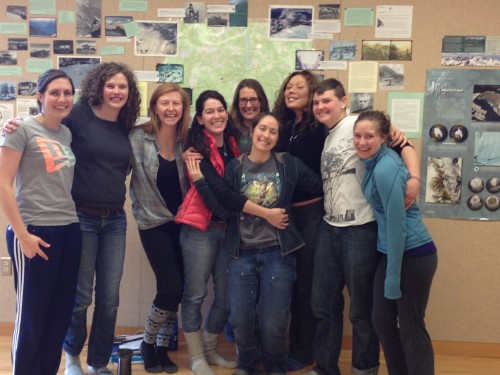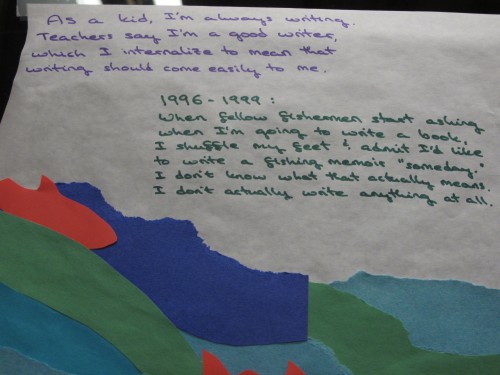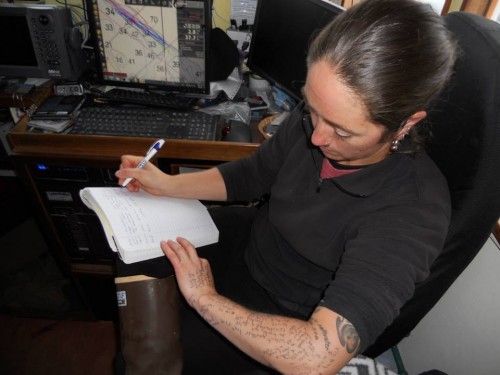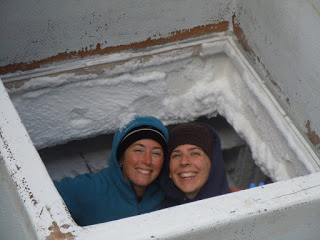Hooked!: Saying Farewell to Our New Friend Tele Aadsen

Crewing on a commercial fishing boat during prime salmon season isn’t exactly conducive to writing a memoir.
“No writing happens on the boat except on my arm,” said Tele Aadsen, a fisherman, writer, Alaskan and most recent Writer-In-Residence at the North Cascades Institute.
But to write a complete log from the Gulf of Alaska, and then some, sentences via forearm and rare moments of rest would not suffice. With a manuscript due by the end of May 2014, Aadsen needed space, time and distance if she were to finish writing her memoir, Hooked: A Season of Love, Sex, and Salmon.
Fortunately, Aadsen was friends with Betsy Delph, a returning sous-chef at the Institute and the daughter of the Institute’s Administrative Assistant, Anne Hubka. Through them, she heard about the residency opportunity and was accepted in June 2013, spending the rest of the summer watching the long Alaskan days tick by until she could trade a salmon knife for a pen come mid-November.
Aadsen’s next three months living at the Environmental Learning Center were productive, but not always blissfully easy, as most artists under deadline to get into “the flow” likely understand. On a recent night in February, Aadsen gave a farewell presentation to the Learning Center community detailing the opportunities, highlights and challenges of her residency. She described it, in part, as an exercise in “forced accountability,” saying, “I have backed myself into this corner that I’ve spent the past 17, 18 years strenuously avoiding.
Even at the young age of 18, fellow fisherfolk had been asking Aadsen when she was going to write a book, to which she’d respond, a little sheepishly, that she would like to……someday. Though she’d been told by teachers and friends since elementary school that writing was a craft at which she excelled, this encouragement did not necessarily translate into a talent that was automatic or without struggle. At age 21, she left the fishing life, and Alaska, at a point when she was, as she recalled, “very angry and bitter.” She spent the next six years as a social worker in Seattle, helping homeless youth. “I bounced from crisis to crisis to crisis,” she remembered. She didn’t write for the entire six years.
Aadsen and Betsy Delph, a sous-chef at the Environmental Learning Center, spent a summer catching salmon together, which included hanging out in the fish hold. Photo by Joel Brady-Power.
But living in a city, passing days punctuated by stress and misery, was hardly sustainable. Aadsen was called back to fishing, a lifestyle she’d known since she was seven when her parents built a 45-foot sailboat, the Askari. At the same time, she was called back to writing: Her story, which she’d spent years trying to ignore, grew louder and more insistent while back on the water.
And then one of those perfect, serendipitous events occurred, the kind that practically force one to believe in fate. In 2010, Aadsen was visiting Bellingham, where she stopped by the independent bookstore and community hub, Village Books. The author giving the reading that evening was Cami Ostman, a former social work colleague of Aadsen’s from a decade previous. “’Someone I know wrote a book!’” Aadsen thought, surprised and delighted. After the reading, her old friend told her that non-fiction books can be sold on proposal, unlike fictional novels, which have to be fully completed. Within three years, under Ostman’s tutelage and encouragement, Aadsen had finished a 100-page proposal for Hooked. Her agent sent it out.
Four of the ten publishers to whom the proposal was pitched wanted to talk about turning it in to a book. All of them were in New York. “None had ever been near a fishing boat, XtraTuf boots or Alaska,” Aadsen laughed. Each publisher singled out a different piece of the story that spoke to them, yet only one, Riverhead Books, identified that there was a feminist component in Aadsen’s life as a female in a male-dominated industry. This was important to Aadsen, and she went with Riverhead, ready to join the ranks of writers such as Anne Lamott and Khaled Hosseini, author of The Kite Runner and A Thousand Splendid Suns.
 At Aadsen’s presentation to the community, she posted a beautifully-crafted timeline of the progression of Hooked around the Dining Hall. How could any creatively-driven person not find solace and empathy in the top quote: “As a kid, I’m always writing. Teachers say I’m a good writer, which I internalize to mean that writing should come easily to me.” Photo by Katherine Renz.
At Aadsen’s presentation to the community, she posted a beautifully-crafted timeline of the progression of Hooked around the Dining Hall. How could any creatively-driven person not find solace and empathy in the top quote: “As a kid, I’m always writing. Teachers say I’m a good writer, which I internalize to mean that writing should come easily to me.” Photo by Katherine Renz.
Now came the hard part – getting her whole story on paper – a task accompanied by even trickier questions: How does one tell their own stories – ones that are funny, sordid, emotional and everything in between — when they involve other people? At what point is the line drawn between characters in a book and friends in real life? With memoirs, does such a line even exist?
The residency offered Aadsen a freedom impossible to access while in proximity to her loved ones, whether working at sea or landed at her permanent home in Bellingham where her partner, Joel Brady-Power, and cat, Bear, held down the proverbial fort until the season began again. Up at the Learning Center, if she wanted to tell a story that could potentially offend a friend or family member, well, so be it. Aadsen could shrug off the concern. “It doesn’t matter, they’re down river,” she’d remind herself, and start writing.
Aadsen also wrestled with issues of shame. Not only was this a theme in her memoir – What does it mean to be faithful? To love? To delve deeply into one’s own secrets? – but it was also an issue with the luxury of a residency itself. With the constant reflection so characteristic of writers, Aadsen wondered, “Who gets to run away for three months to write a book?”
Part of the answer was found in one of the dozens of letters friends and fans sent her during her three months, some of which she shared during her presentation. As one woman wrote, “You valuing your work gives me permission to value mine.” The humanity of Aadsen’s task became apparent, as a model for others wanting to embrace their creative goals but also in considering how to take Hooked to a deeper, more universal level. “How can I make this no longer my story only?” she asked herself, chapter by chapter. With the popularity of memoirs over the past decade or so, with authors like Cheryl Strayed agonizing over love and loss on the Pacific Crest Trail or Elizabeth Gilbert traipsing all over the world to find herself, this format has often been criticized for its narcissistic tendencies. Aadsen’s intention was to escape this inherent pitfall as much as possible, to craft a story in which readers can better understand their own experience through her experience.
As a graduate student and year long resident at the Environmental Learning Center, welcoming Aadsen into our lean wintertime community was a sweet opportunity. I remember the autumn afternoon when Anne Hubka mentioned we would have a writer-in-residence, the same woman who provides all the salmon we serve in our kitchen. An author? I thought. A real live writer? Who is also a feminist? YES! My initial assumption to jump for joy proved correct as we got to know Aadsen over the next few months. Though she was, most of the time, diligently locked in her apartment organizing words, Aadsen always made time for her new family, including leading an all day writing workshop for the graduate students, one of the highlights of our educational experience. I can’t count the number of times I heard her say, “There’s a book in you….,” extending the encouragement she’d received along her own journey to the writers among the graduate cohort and staff.
Tele Aadsen became and remains part of our community and part of our story as, we hope, we are a part of hers. We’re hooked.
 Memoirs are an internal story, but sometimes they’re external, too: Aadsen doing her daily ritual on the boat, pre-residency, transcribing her inspired notes-on-forearm into a more permanent journal. Photo by Joel Brady-Power.
Memoirs are an internal story, but sometimes they’re external, too: Aadsen doing her daily ritual on the boat, pre-residency, transcribing her inspired notes-on-forearm into a more permanent journal. Photo by Joel Brady-Power.
Leading photo: Aadsen and the graduate students (collectively known as “Cohort 13”) pose for a farewell photo. Obviously, we wish she could be our constant writer-in-residence. From L to R: Sarah Stephens, Annabel Connelly, Katie Komorowski, Samantha Hale, Katherine Renz, Tele Aadsen, Elissa Kobrin, Kaci Darsow, Tyler Chisholm. Photo by Liz Blackman.
Katherine Renz is a graduate student in North Cascades Institute and Western Washington University’s M.Ed. program and co-editor of Chattermarks. When not doing homework or blogging, she is dreaming of being a writer-in-residence.


